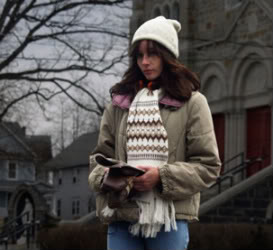|
In the 1980s, nearly seventy percent of Americans believed in Satanic ritual abuse-so the opening text tells us. I was there in the '80s, and that sounds about right. Dimwits of all political persuasions wrung their hands at PTA meetings and played heavy metal records backwards in church basements, obessed with the thoroughly ridiculous notion that the country was overrun with black-robed cults that stalked suburbia for infants to eat whilst listening to Ozzy and Judas Priest. Every generation has its own special breed of imbecile: they had the Satanic Panic, we have people who click "like" on Sarah Palin's Facebook page. It's this recent era that indie auteur Ti West recreates most successfully in his old-school horror flick The House of the Devil. 
College girl Samantha needs a place to live, and interviews with the landlady of a rental house. She gets accepted, but there's one persnickity problem, in that she doesn't have the money for the down payment. Passing an ad posted on campus asking for a babysitter, she sees a way out of her predicament, at least in part. Her friend Megan drives her to the remote house, as Samantha has no car, and harbors vague concerns. Something seems off about the whole deal. Indeed, something is: there is no child at the home, but rather the client's aged mother. The genteel Mr. Ullman ups Samantha's fee, apologizing to her for the mislead. Four hundred dollars for four hours sitting for an old woman who, as Mr. Ullman indicates, is unlikely to even leave her upstairs bedroom, is too good a prospect for the cash-strapped Samantha to pass up. Megan is furious at her friend's decision, as things are clearly not as described, and might be even weirder than apparent. It's true of course-note the title of the film-but the characters in the story lack the perspective of an audience member who knows he's watching a horror film. The job, after all, seems simple enough. This is, by clear design, the kind of film they don't make anymore. Not only is it set in the 1980s, it's intended to look as though it was actually filmed in the 1980s, and succeeds wonderfully. From the choice of camera angles and film stock to the cheesy synthesizer score to Samantha's Jordasche jeans and feathered hair, everything screams retro. It's not in the service of irony or parody; the film is sincere in its ambition. Its director clearly wanted to make a genuine '80s scare flick that might well have been found in a time capsule after a quarter-century, with no knowing winks at the audience or self-aware digs at the now-hokey-seeming styles of bygone days. This is not a film of the Jason/Freddy pedigree, but rather a film predicated on suspense, evoking John Carpenter at his better moments. What exactly is happening at the titular house is slowly revealed by Samantha's explorations. Clues that the absence of a baby to sit may be the least of the lies she's heard begin to mount. Not clues in the sense of bloody clothes or racks of butcher's knives, but more subtle hints of information that contradict what we think we knew. This is delightfully done with virtually no exposition, as exposition virtually requires conversation, and for much of the film we're spending time with a single character. Most of the time, we share in Samantha's discoveries; at other times, we are shown things that she is not. Events, small and There is, when all's said and done, an inequity in Ti West's ambitions with this film. It's obvious that he dearly wanted to make a film evoking the style of '80s horror films, and put forth much effort in so doing. However, it appears that he was content to go no further, as it comes off as simply an '80s horror film, with no indication that its maker aspired to create the '80s horror film. It does its job and does it well, but gives no impression that it's been any sort of defining statement. It's also true that, in order to generate suspense, the story often leaves logic in the dust. Without giving anything away, I'll simply say that there's a nefarious plan at work, which is much more elaborate than truly necessary to accomplish its goals. To rationalize much of what happens would require the sort of exposition the film thankfully shuns, but one can't help but wonder if some better construction might've obviated the need entirely. It's a good film, but not a great one, though it does, in the manner of many great entries in the genre, allow the viewer to equivocate on the existence of the supernatural; one could rationally explain nearly everything that happens, at least inasmuch as the existence of Satanic cults can be deemed a rational proposition. Hell, there's probably a few here and there. Prentention knows no boundaries, after all. It should be mentioned that the film has a very measured pace which may be tedious for fans of modern horror, or even of slasher films from decades past, with their ridiculous kill quotients. Here we have the pleasure of pulling for a heroine that's actually likeable, thankfully putting audience investment back with the protagonist instead of with some ludicrous, unstoppable killing machine or torture-loving sadist. Gore is sparing used, such that it feels actually shocking when it appears. Despite its flaws, it's a film which prompts me to watch its creator's future work with interest. It's also utterly hilarious to read online posts by people complaining that films like this give Satanists a bad name, but those sorts of emo asshats are always funny. -review by Matt Murray
|
|
||||||||